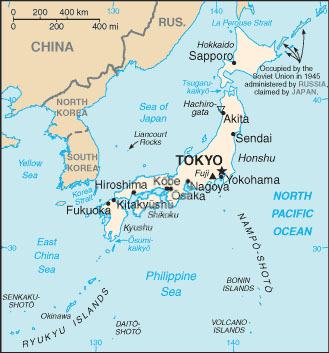 |
 |
MOUNT FUJI - JAPAN
 |
 |
| Location: | Geographic coordinates: | Area: | Area - comparative: |
| Eastern Asia, island chain between the North Pacific Ocean and the Sea of Japan, east of the Korean Peninsula. | 36 00 N, 138 00 E | total: 377,915 sq km | slightly smaller than California |
| Population: | Languages: | Capital: | Currency: |
| 127,078,679 | Japanese | Tokyo | Yen (JPY) |

| Types of rocks: | Mount Fuji of andesite with a some basalt under layers. |
Mount Fuji is the highest mountain in Japan at 3,776 m (12,388 ft). It is still an active volcano that last erupted in 1707–08. Mount Fuji's exceptionally symmetrical cone is a well-known symbol of Japan and it is frequently depicted in art and photographs, as well as visited by sightseers and climbers. Geologist have identified four distinct phases of volcanic activity in the formation of Mt. Fuji. The first phase, called Sen-komitake, is composed of an andesite core recently discovered deep within the mountain. Sen-komitake was followed by the "Komitake Fuji," a basalt layer believed to be formed several hundred thousand years ago. Approximately 100,000 years ago, "Old Fuji" was formed over the top of Komitake Fuji. The modern, "New Fuji" is believed to have formed over the top of Old Fuji around 10,000 years ago. The volcano is currently classified as active with a low risk of eruption.
© Guillermo Rocha, P. G. / Brooklyn College Geology Department